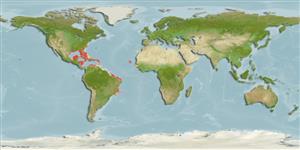Preferred temperature (Ref.
123201): 20 - 27.5, mean 24.8 °C (based on 196 cells).
Phylogenetic diversity index (Ref.
82804): PD
50 = 0.5005 [Uniqueness, from 0.5 = low to 2.0 = high].
Bayesian length-weight: a=0.00069 (0.00033 - 0.00144), b=3.12 (2.93 - 3.31), in cm total length, based on LWR estimates for this (Sub)family-body shape (Ref.
93245).
Nivel trófico (Ref.
69278): 3.4 ±0.5 se; based on size and trophs of closest relatives
Resiliencia (Ref.
120179): Alto, población duplicada en un tiempo mínimo inferior a 15 meses (Preliminary K or Fecundity.).
Fishing Vulnerability (Ref.
59153): Low vulnerability (10 of 100).
Nutrients (Ref.
124155): Calcium = 70.9 [39.1, 148.9] mg/100g; Iron = 0.63 [0.37, 1.20] mg/100g; Protein = 18.5 [16.2, 21.1] %; Omega3 = 0.162 [0.070, 0.501] g/100g; Selenium = 41.3 [21.3, 91.0] μg/100g; VitaminA = 111 [31, 369] μg/100g; Zinc = 1.24 [0.85, 1.76] mg/100g (wet weight);
